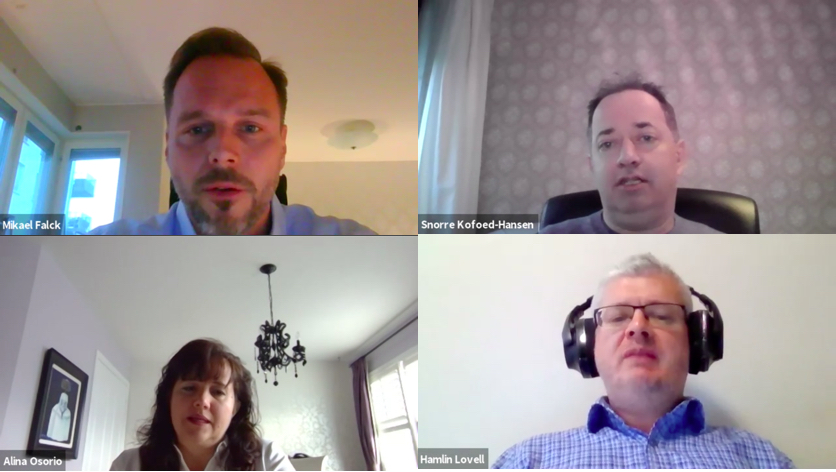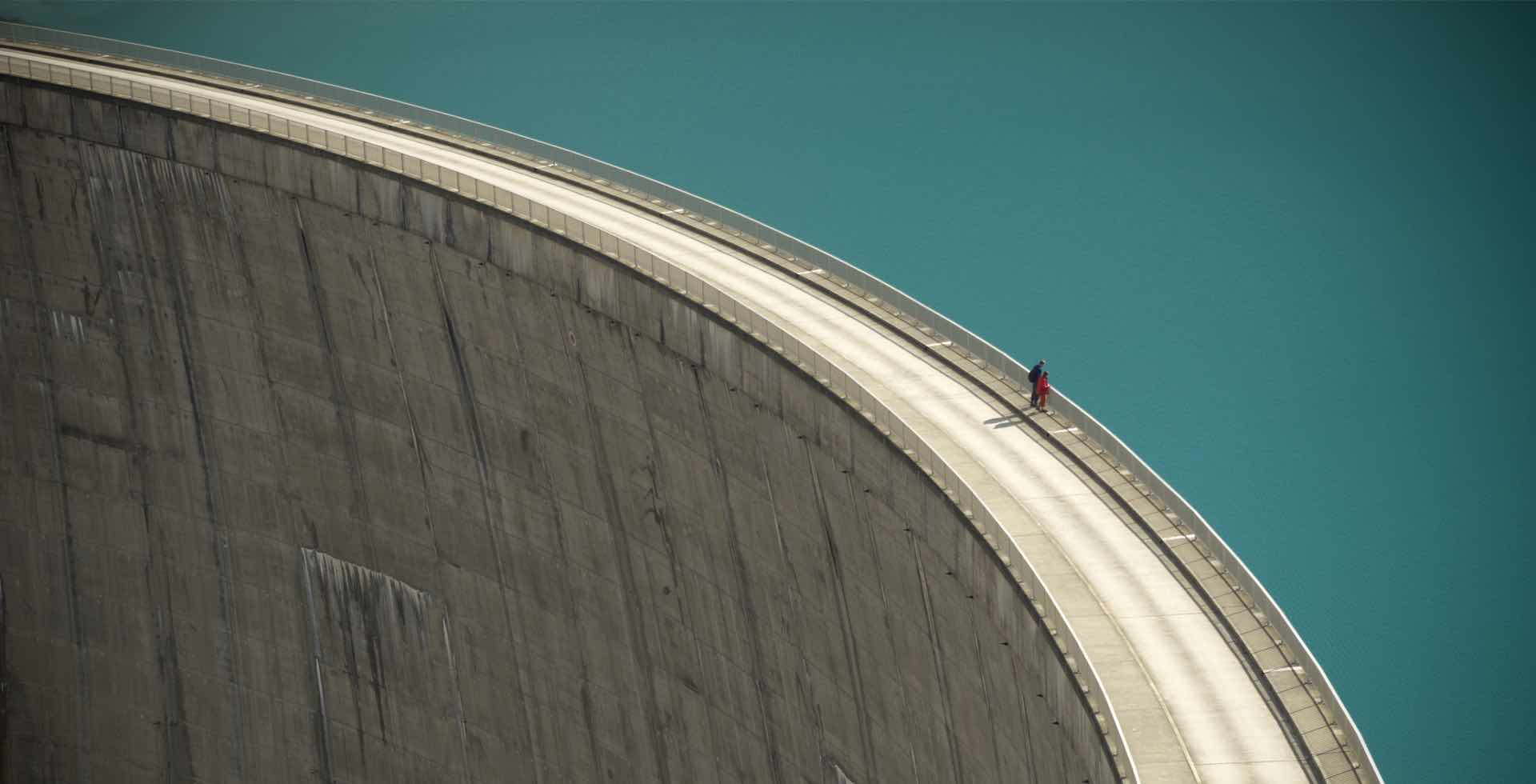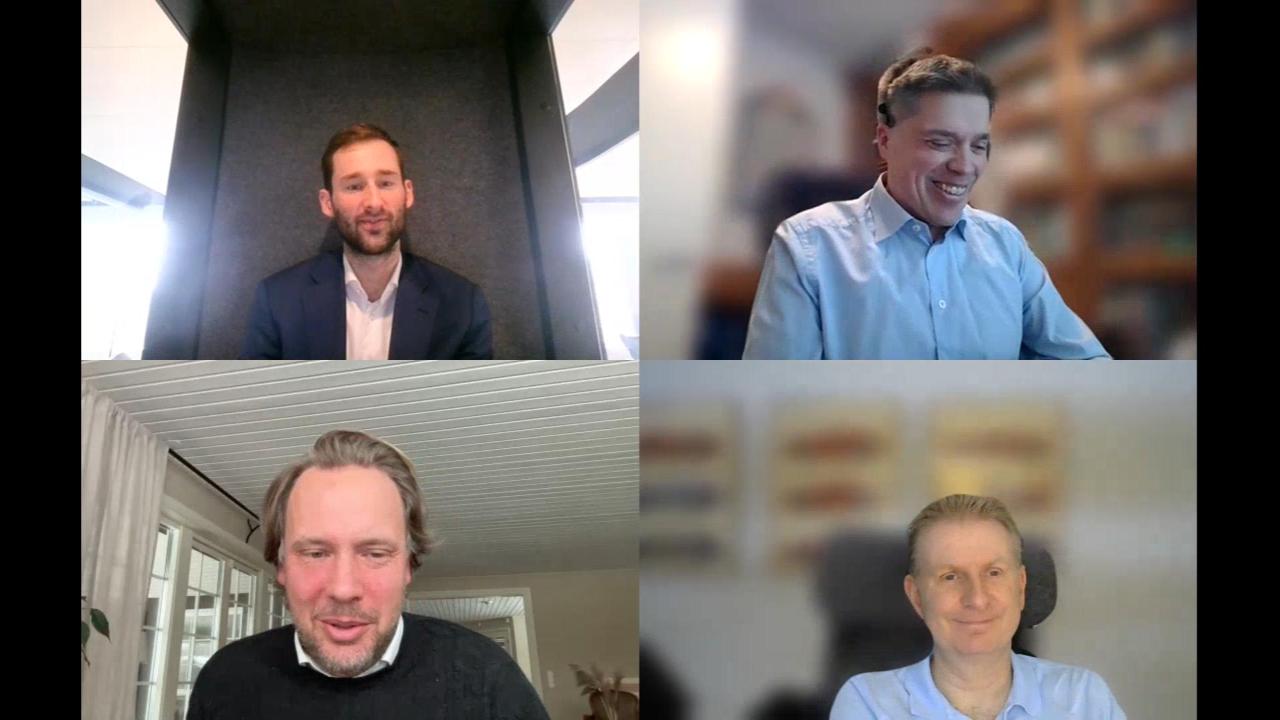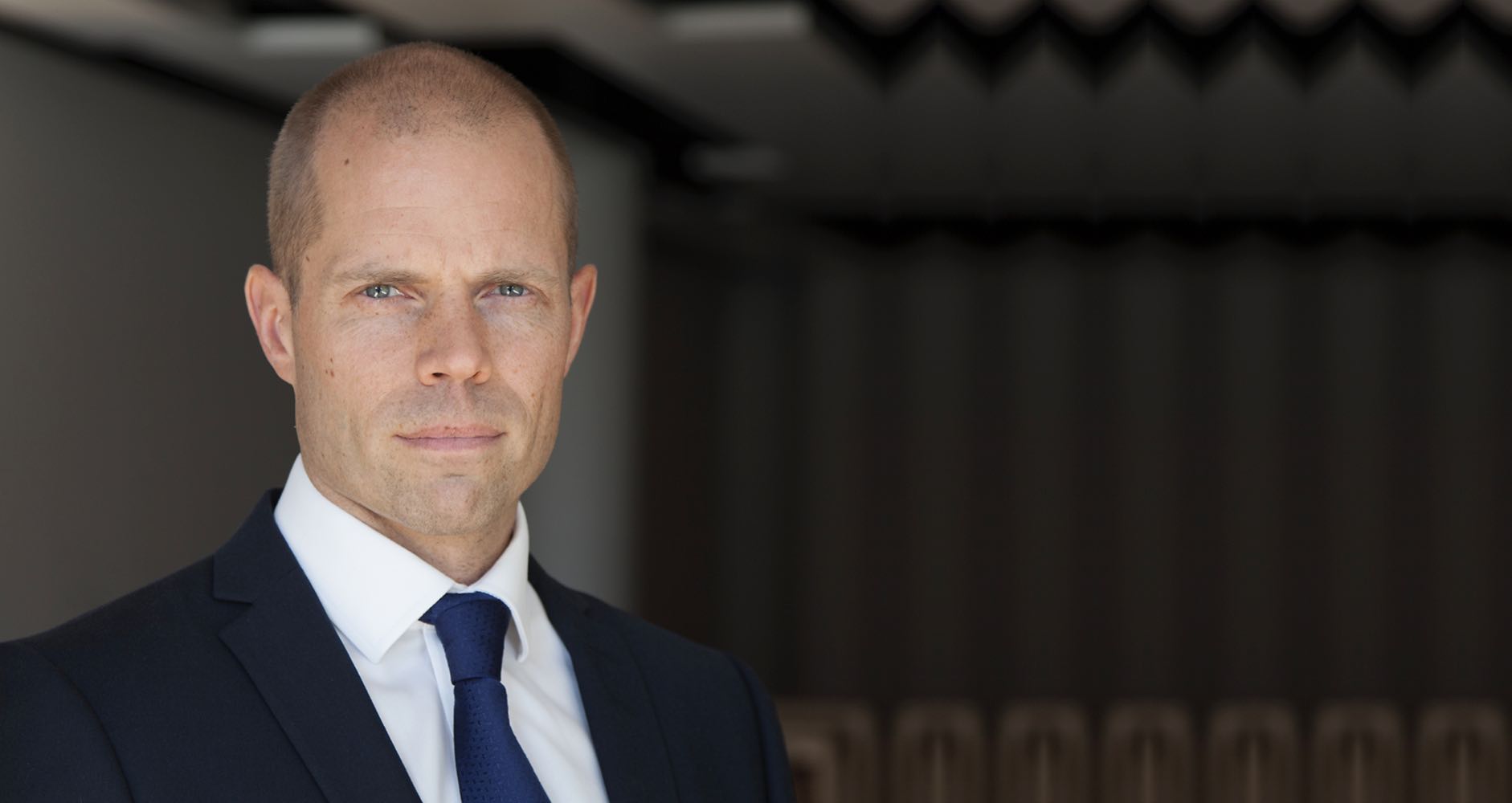The search for yield as well as growth is leading to growing Infrastructure allocations. Much of the asset class has remained resilient in 2020 and although competition for some assets has reduced expected returns, it is a growing asset class with new opportunities emerging. If Covid 19 has accelerated the digitization megatrend it has also heightened interest in decarbonization as lockdowns have very visibly cleansed the air and cleared the skies. Infrastructure dovetails very well with Nordic institutional investors’ ESG policies and priorities. The asset class can be accessed through a variety of vehicles, structures and models. NordicInvestor contributing editor, Hamlin Lovell, moderated a roundtable discussion amongst managers, pension fund and insurance company allocators.
Read this summary or click the image below to watch the full discussion on Vimeo.
Panelists; Mikael Falck (top/left), Snorre Kofoed-Hansen (top/right), Alina Osorio (bottom/left) and Hamlin Lovell (bottom/right)
Mikael Falck, Head of Alternative Investments at Kåpan pensions in Stockholm. Kåpan is a public pension fund, managing occupational pensions for public and state employees in Sweden. AUM is roughly 10,5 bn EUR. “Kåpan has 15% in real assets, including infrastructure, real estate, timber and farmland, of which 2.2% is currently in infrastructure. We expect that this could grow to 3-4%”, he says. “
Alina Osorio, President of Fiera Infrastructure, has spent her entire 25-year career in the infrastructure asset class, spanning roles including investment banking, financial advisor, GP principal and pension fund fiduciary principal. She is currently responsible for leading Fiera Infrastructure consisting of a team of 24 professionals across three offices, Toronto, NYC, and London. The strategy invests in infrastructure equity, across core and core plus investments, globally in OECD countries and focused on the mid-market. Current AUM for FII is approximately $2 billion, with approx. $400mm at the regulatory approval stage. “North American institutional investors sometimes have as much as 10-20% allocated to infrastructure”, she says.
Snorre Kofoed-Hansen, Senior Portfolio Manager at Velliv, since 2019. He covers infrastructure and private equity and has been working with alternative investments since 2015. Velliv manages over 200 billion Danish Krone (EUR 26 billion) and 350,000 customers. “Our Infrastructure allocation is currently fairly small, but we are looking to increase the allocation the coming years”, he says.
Income and growth targets
Infrastructure is a versatile asset class offering a balance between income and growth across a spectrum of risk profiles. Infrastructure debt could offer some yield pickup over investment grade corporate debt while some forms of core infrastructure equity can in fact provide more yield than high yield corporate debt and core plus can compete with private equity total returns. “Fiera allocates around 70-80% to core with the rest in core plus. The core transactions are expected to make single digit returns with a healthy yield while core plus are intended to deliver double digit returns. The blended average of the two types is targeting 10-12% nominal returns, of which half is expected to be yield”, says Osorio.
Kåpan has a barbell approach with lower risk, core infrastructure, expected to return 6-9% with a higher income component, while higher risk, more opportunistic, core plus allocations are expected to make low to mid teens….”
– Mikael Falck, Kåpan
“Velliv is focused on core and core plus managers, and targets 8-10% returns, of which 4-6% is income. We are focused on lower risk/returns in our Infrastructure portfolio as we use it as a stable building block in our Asset Allocation. We mainly invest in infrastructure for the stable cash flows and inflation linkage. We use Private Equity for taking more risk and to increase the expected return. Solvency II insurance regulations also encourages us to have more in core”, says Hansen.
Regulated and contracted assets steady in 2020
Returns have generally been resilient in 2020 because all participants are predominantly invested in regulated and contracted assets, with limited exposure to GDP or travel related assets. “Kapan’s infrastructure allocation has been resilient because only 23% of our infrastructure is GDP sensitive, and also fortunate that some airports and transportation assets were sold pre-Covid”, says Falck.
Velliv’s overall returns in infrastructure have been fairly stable this year. We did see some valuation write downs for airports and train operators in the first and second quarter of 2020, but these assets are only a minor part of the overall portfolio….”
– Snorre Kofoed Hansen, Velliv
“Fiera has found regulated and contracted assets were incredibly resilient, though we had one traffic related asset that saw a temporary valuation hit based on Covid-19 related cashflows, which are now recovering. This crisis has tested infrastructure, which has proven to be quite resilient exiting it”, says Osorio. Infrastructure equity assets often employ some leverage and infrastructure valuations have made a V-shaped recovery partly because credit markets have primarily been unaffected by the Covid crisis.
Developed market focus
Resilience in 2020 has also been supported by a focus on developed markets, which have seen a more powerful fiscal and monetary policy response and a faster recovery than have many emerging and frontier markets.
Fiera is entirely in the OECD, with an approximate split of 50% North America versus 50% Europe, and some opportunistic allocations in Australasia. We are also looking at opportunities in Chile….”
– Alina Osorio, Fiera Infrastructure
“Velliv’s infrastructure allocation is 50% in Europe, 35% in North America and 15% in Asia, Australasia and South America”, says Hansen. “Kapan is 65% in Europe, 29% in the US and the rest in Asia”, says Falck. A change in US tax policy has spurred overseas investors to diversify into US assets: “the bias to Europe partly relates to a historical tax issue that disadvantaged non-US investors in US real assets. We have only just started investing in the US in the past few years”, says Falck.
Large and mid-market opportunities
The scale of infrastructure assets can range from tens or hundreds of billions all the way down to a single project, such as a small wind or solar farm, that might be worth only a few million. In between these extremes, the “mid-market” is a natural area for medium sized investors and managers and is a broad segment that can be defined either by project or fund sizes. “Fiera has 35 mid-market investments and defines the mid-market as equity of USD 250 million or lower or an enterprise value of USD 1 billion or below, says Osorio. Falck finds it more convenient to define the mid-market in terms of fund sizes, and “we draw a line at roughly USD 3 or 3 or 5 billion for infrastructure, which is higher than our 1bn cut off for private equity….
Over the past decade of investing in infrastructure, Kåpan’s average fund size has grown not because larger managers were sought out but simply because as the asset class has matured, and good managers have grown….”
– Mikael Falck
Velliv defines a mid-market fund with a slightly lower threshold of USD 2-3 billion and is invested in a mix of large and mid-market managers.
Fiera find the mid market is the sweet spot for returns: “We find there is a large volume of opportunity in the mid market and slightly less competition than in the mega space, which can result in better returns. Projects, companies and transactions tend to be smaller but they take as much work as bigger deals as does the ongoing asset management, so this is harder work for managers”, says Osorio.
Active Management
Mid-market assets can offer more scope for infrastructure asset managers to closely oversee operational teams that manage assets on a day to day basis. “We take a long-term view on supporting assets in terms of business plan, capital, maintenance and operations. Managing what you own is the most important thing in my 25 years of experience. It is critical to be an active asset manager, close to the management team, so we can respond quickly if something does happen”, says Osorio.
We prefer the GP to be actively engaged in active management, and they may have a network of industrial expertise to bring to the table….”
– Snorre Kofoed-Hansen
Falck concurs: “active management is especially important for opportunistic investments where there is more scope to add value”.
Megatrends: different ways to play Digitisation
Returns are also linked to the big picture megatrends driving private infrastructure equity, which are the same as those powering some of the best performing stocks in public equity markets in 2020. “Digitization is a central trend, which has been accelerated by Covid, and is implemented via mainly communication infrastructure, fibre connectivity, tele towers and data centres”, says Falck. Within this wide range of sub-sectors, Fiera has prioritized a specific segment as a compelling area: “Fibre backbone or fibre to the home is now the fourth utility, after gas, electricity and water, as society needs more connectivity and fibre capacity”, says Osorio. Digitisation assets can have a range of risk profiles that will not suit all investors however: Hansen observes that, “shorter duration data assets such as data centres are not always classified as “core”.
Megatrends: Decarbonisation
Decarbonisation is has gathered momentum in 2020 not only because lockdowns have reduced carbon emissions for the first time in decades, but also because President elect Joe Biden will commit the US to the Paris agreement and can push through much of his green agenda using executive orders. But the most popular assets may not meet all investors’ return targets.
“Decarbonisation provides a very interesting and concrete way to play sustainability, most obviously in renewables but also through the global energy transition trend that can offer higher returns”, says Falck. Osorio is also cautious on the return outlook for some renewable assets;
disruptive trends in energy markets due to forces such as battery technology, and distributed generation, which can make renewable cashflows less predictable….”
– Alina Osorio
Hansen is, “seeking to plug specific gaps in renewables exposure, such as district heating, which had been missing”.
ESG and Nordic thought leadership
Decarbonisation assets are one way to apply ESG policies to infrastructure and strong ESG policies are essential for Nordic allocators. “ESG is politically driven as Sweden takes a leadership role globally in ESG and sustainability. The reputational risk for investors has become quite high if managers do not adhere to a strong ESG and sustainability focus”, says Falck. Hansen agrees: “ESG in Denmark is also very politically driven megatrend on everyone’s agenda and has come a long way over the past 3-5 years. It is now a license to operate in the long run for most institutional investors. It is also natural for managers investing in long term infrastructure assets with lives of 10,20 or 30 years”.
Evolving ESG standards for infrastructure
Common standards are one way to measure and benchmark managers’ ESG policies. UNPRI is becoming ubiquitous but there are also specialized standards for real assets, such as GRESB. “The UNPRI is pretty much a prerequisite to start seriously looking at a manager. GRESB is also a good benchmarking tool and we do like to see higher scores, but we also need to take a holistic look at how managers implement sustainability and see what they have done on an asset level, for all ESG aspects and assets”, says Falck. Hansen also finds that;
UNPRI is always a focus. An important part of our due diligence is looking at how managers implement ESG, acquire new assets, communicate with management of portfolio companies, and report parameters to investors….”
– Snorre Kofoed-Hansen
Says Osorio: “GRESB is more onerous and extensive than UN PRI for infrastructure. It is a more granular and thorough deep dive into each underlying asset as well as funds and portfolios. We work with management teams and operators to ensure the appropriate information is sent to GRESB. We are participating in GRESB for the second year and investors are asking for it”. GRESB is only one part of Fiera’s ESG framework: “we are thinking holistically about E, S and G as part of our approach to ESG for both the investment and asset management side”, she adds.
Open-ended or closed-ended vehicles?
Infrastructure can be housed in open ended or closed ended vehicles and each type has its pros and cons. “We have both open and closed end funds, and will allocate to one of each this year. For an open ended fund you have to trust the independent valuation of the fund before you trade it. The main advantage of an open ended fund is that managers are not forced to sell assets to meet maturity targets. An open ended structure can give managers more freedom over timing their exits. We also save on the transaction costs of carrying out due diligence and legal work on new vehicles”, says Hansen. Closed end structures also have their advantages: “We are fans of closed end structures with a defined life or term because this incentivizes the GP to deliver both IRR and return multiples within the set timeframe. And the need to raise assets forces the GP to show their worth in every new fundraising. It is also easier for me as a portfolio manager to run an investment programme by recycling the proceeds from older funds into new fund commitments”, says Falck.
Having said that, if any asset class within alternatives benefits from open ended structures, or at least longer-term lives, it would be infrastructure, and we do invest in open ended funds for core infrastructure….”
– Mikael Falck
Where there are very long-term underlying contracts an open ended fund structure avoids a mismatch between contract terms and fund terms”, he adds. Osorio agrees: “We have chosen open ended vehicles as we fundamentally believe the infrastructure asset class should be viewed through the lens of long-term investing”. She further argues that, “open ended funds provide a flatter J-curve and a shorter path to yield”.
Open ended funds need not preclude redemptions: “investors control exit via a feature that lets them partially or wholly redeem on their own if they need to rebalance portfolios”, says Osorio. There can also be a secondary market for LP interests.
Accessing fee discounts and co-investments
Fees are one constraint that limits the size of many pension funds’ allocations to alternatives including infrastructure. The main two ways to reduce fees are larger tickets or co-investments, but neither is straightforward. “A prolonged bull market has played in favour of GPs so that fund terms have become more GP friendly. In tiered management fee structures higher minimum ticket sizes are now required in order to qualify for lower fees”, according to Falck.
Co-investments can have zero management and performance fees;
We provide zero fees co-investments for investors up to the amount they have committed to the fund. This is a very efficient way to reduce fees and for investors to get more exposure to the assets they like, and avoid co-investments in others….”
– Alina Osorio
However, a challenge of co-investments is whether managers have the internal resources to research and monitor them. “We would love to co-invest in order to save on fees but we do not have the manpower or organisation to react fast enough and do due diligence within tight deadlines that can be as tight as two weeks”, says Falck.
Pooling resources with other allocators through syndicated deals could be a solution, letting medium sized allocators both access lower fee share classes and no fee coinvestments: “we have sometimes done club deals which eliminate all costs apart from structuring and setup”, says Hansen. Nordic Investor has interviewed investment consultant COIN which sets up vehicles that aggregate investments from multiple “second tier” institutions to secure lower fees.
Are inflows eroding returns?
“We have seen a downward trend in returns in the infrastructure asset class as a whole partly due to the very low interest rate environment but also due to the amount of capital flowing into the space”, says Osorio. For example, some infrastructure funds have taken advantage of higher valuations for renewables and monetized their holdings, reducing exposure, while some allocators have shifted renewables into a lower return sleeve:
renewables have moved from our opportunistic bucket to our core bucket. We still have a fairly big exposure as broader global mandates can have 20-40% in renewables, and larger global players may achieve economies of scale in this area….”
– Mikael Falck
It is getting harder and harder to find worthwhile investments in renewables as government subsidies are withdrawn, and nobody knows where power prices will be given the disruptive changes we are seeing in new technologies and electricity markets. Overall project risk is increasing as assets have more merchant risks rather than long term contracts with utilities or governments”, says Osorio. Hansen also has an uncertain outlook for some assets: “there is very much competition for certain areas of renewable assets. We have 40% of our infrastructure allocation in renewables right now, and will probably not increase that as we do not want too much exposure to electricity prices 5-10 years from now between the expiry of PPAs and the end of life for wind farms”.
Redefining infrastructure as the asset class broadens out
Though returns can come down as some sub-sectors become overcrowded, active allocators and asset managers are seeking out new areas that may provide an early mover advantage. “We are at least mentally prepared for lower risk adjusted returns as the market becomes more efficient. But as the asset class becomes broader new opportunitiesmay offset the decline in returns from market efficiency”, says Falck. Osorio has a similar vision: “as the definition of infrastructure becomes broader, there are still ample opportunities to invest for returns of between 8% and 12%. As infrastructure becomes more widely accepted, new sectors – such as water and waste infrastructure are allowing private capital in Canada – and other sectors are being privatized, which opens up new sub-sectors for the next decade, just as telecoms was privatized a few years ago”. Falck highlights another new sub-sector: “farmland, along with the handling, moving and storing of food products, can now be classified as “agricultural infrastructure”, and it remains to be seen if this becomes a mainstream sector”.
Of course, the disciplined financial forecasting of top and bottom lines remains the same for new sectors: “as the boundaries of infrastructure are redefined, we focus on looking at the drivers and predictability of revenues, which are the real differentiator”, says Osorio.
Covid 19 and remote due diligence
Allocators and manager are clearly actively looking to deploy capital, though their modus operandi has adapted to Covid restrictions. “Deal flow has not slowed and new transactions have come to the market. People are adjusting to remote management presentations. We may rely on locals for onsite visits and due diligence, though normally one of our team will go at the same time”, says Osorio.
We would typically like to see operations and assets but since March, we have only done remote meetings using zoom or teams. This has worked well so far….”
– Snorre Kofoed-Hansen
“We are struggling with having to do remote DD. Like any LP, we had an active pipeline of new investments going into Covid, mainly with managers we knew from before. We are now however facing the fact that we might have to invest with a manager that we have never met physically. We normally have a requirement to see all managers in their own premises on site, but we must adjust and cope with reality.”, says Falck.
Please leave us your email below to access to the full discussion on both video and audio.



